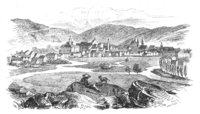Categories Online-Shop Germany German States until 1871 Eichstätt
Eichstätt

Willibald, coming from a noble English family, was raised in 741 in Thuringia as bishop and then took over his diocese in Eichtstätt. He is considered the founder of the place and the diocese. Until the 9th century, the sources are silent about the new diocese. Only with Erchambald (882-912) then begins the traditional coin history of the place: on February 9th, 908 king Louis the Child Eichstätt market and coin right, which is due to the politically skilled moves of Erchambald. From the time of the end of the century, the first denarii were preserved, which continue to be struck until the 11th century.
After a coinless period, the bishops started in 12th century minting coins again, this time pennies and halflings. These coins have probably never gained more than local importance and soon another hiatus in the coin production ensued. For 250 years, until the end of the Middle Ages, Eichstätt has not struck coins. Under bishop Gabriel of Eyb (1496-1535) begins the production of gold guilders and shillings; the oldest pieces bear the date 1511. The Eichstätt coins of modern times are mostly from non-local workshops, often from Nuremberg. At the latest under Johann Conrad of Gemmingen (1595-1612), the first thalers of the diocese were minted.


